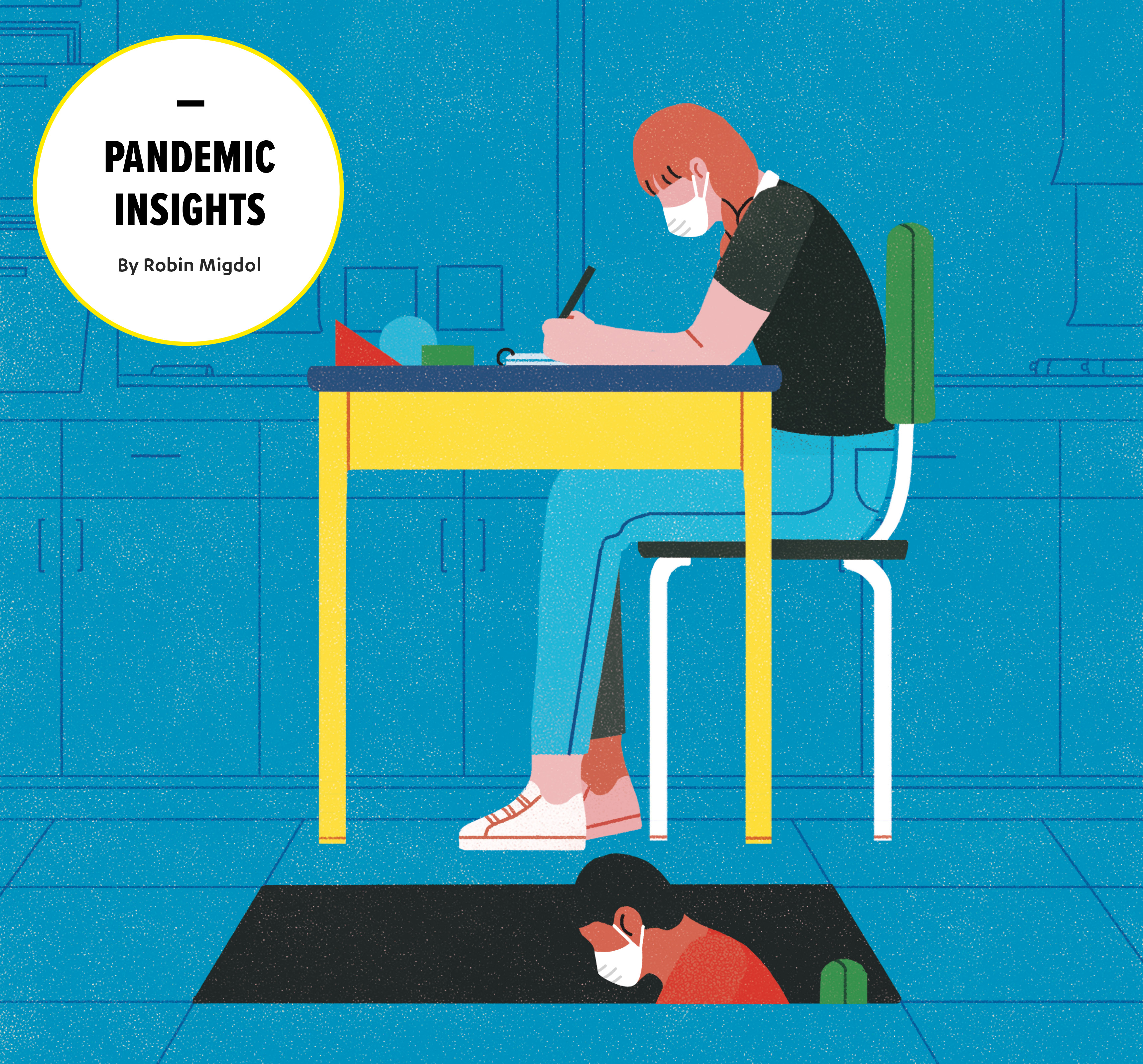The Uneven Impact of Remote Learning

By Robin Migdol | Illustration by Jeannie Phan
Among the classes in UCLA’s vast course catalog, “Health Disparities and the Environment” might not stand out, but undergraduates who enroll in it have a remarkable opportunity: They get to do research under the guidance of senior faculty in the ecology and evolutionary biology department.
A yearlong research course series with biology professor Paul Barber, the class is geared toward sophomore pre-med students from underrepresented groups to support their success in STEM (science, technology, engineering and math) majors and maintain their path to medical school.
When UCLA transitioned to remote learning at the start of the COVID-19 pandemic in March 2020, Barber and his students were faced with a question: How do we continue the research component of the class?
They had been preparing to research food-insecure communities of color in Los Angeles by interviewing people fishing at local piers and testing fish samples for chemical and microbial contaminants. But with the rise of COVID-19 and UCLA’s switch to remote learning, interviewing people in the community became impossible.
The students could easily have put all their research projects on hold until they could return to campus. Instead, they embarked on a new project to research disparities in how they and their peers were adjusting to remote learning.
RESEARCH IN REAL TIME
“The students decided they wanted to develop a survey to under-stand the experiences of UCLA students during remote instruction and try to understand whether the challenges that they were facing were unique to them,” Barber said.
Soon after UCLA had transitioned to remote learning, the campus launched several initiatives to help students. The Bruin Tech Grant provided laptops, Wi-Fi hot spots and tablets to students who needed them. The Administrative Vice Chancellor, UCLA Student Affairs and UCLA Library also published guides to help students stay organized, access digital resources, and manage their health and wellness.
Yet despite UCLA’s efforts to support students as they began learning remotely, the students in Barber’s class knew there were gaps in how they and their peers were managing.
“Our students realized that the experience they were having with remote learning was not necessarily the same experience that other students were having,” said Barber, who also directs the Undergraduate Research Center’s Program for Excellence in Education and Research in the Sciences (PEERS).
With the support of the Center for the Advancement of Teaching, Center for Educational Assessment, the Academic Advancement Program, the registrar’s office, and then-Dean and Vice Provost of Undergraduate Education Patricia Turner, the students created a survey that was distributed to a random sampling of 20% of the undergraduate student body.
The survey included questions about student satisfaction with remote learning, technological barriers, ability to focus, student time demands, living situation, added responsibilities, financial issues, food insecurity and other COVID-19 related obstacles. The results showed that first-generation students and students from underrepresented communities, as well as STEM students, found the transition to remote learning more difficult than other students.
“One staggering statistic found was that technology limited the ability to engage in remote instruction for 42% of first-generation and 36.6% of underrepresented minority students,” said Jennifer Navarez, one of the student researchers who is now a senior majoring in human biology and society. “In addition, STEM students were less satisfied than non-STEM students with remote instruction.”
Student researcher and junior psychobiology major Alison Menjivar said, “All three groups experienced technological challenges such as Wi-Fi problems because they didn’t really have any access to a computer at home; they always relied on the technology at school. And then, this probably interfered with their participation in the classroom. So some people might not have been able to participate in discussions or attend lectures.”
INSIGHTS INFLUENCING CHANGE
Barber and the students organized their data in a report that was shared with Turner and others in the UCLA administration, including the Center for the Advancement of Teaching (CAT) and the COVID-19 continuity task force. Barber said there was “tremendous” interest in the survey’s findings, and while the campus had already enacted initiatives to support students during the pandemic, simply raising awareness of students’ experiences made a difference.
“Just by understanding the challenges students are facing, it increases faculty empathy for what students are going through,” Barber said. “Having that data and seeing the results is quite sobering. It’s made me think a lot more about the welfare of my students, and I checked in with them more to see how they’re doing.”
Marc Levis-Fitzgerald, director of CAT’s Center for Educational Assessment, said for him the report’s most important takeaway is that challenges faced by underrepresented and first-generation students are the result of disparities that existed long before remote learning began.
“Given that feedback from quarterly surveys of our students during COVID remote learning was generally positive, minus challenges with feeling a sense of community, this deeper look at different groups was enlightening,” he said.
The resulting paper was accepted for publication in the Journal of Microbiology & Biology Education. Levis-Fitzgerald pointed out that completing and publishing a research paper in less than a year is a rare achievement, especially for undergraduates.
Doing research about their own challenges, then presenting that research to campus leaders who have the power to positively influence the students themselves, was a significant opportunity, Barber and the students said.
“I think the most significant outcome of this paper is that it will be used to influence change at UCLA and help assist professors in making equity-minded decisions to support all UCLA students,” Navarez said.
Back to UCLA College Magazine page



